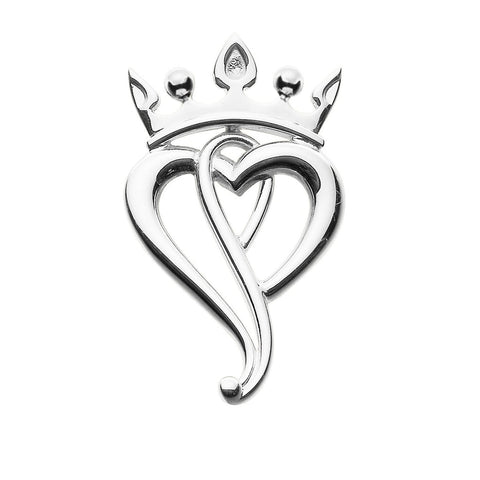Love hearts, lucky charms and an Edinburgh roadblock
Ola Gorie’s Luckenbooth collection is a rare thing.
Most of Ola’s designs are entirely original, or at least bold new creations based on fragments of manuscripts or enigmatic archaeological discoveries. But Luckenbooth is different. Yes, Ola dedicated all her creative imagination to making it special. But it was a special version of a 500-year-old design, passed down through many generations of jewellers, loved and treasured by thousands of Scottish folk over the centuries.
Hearts have been used as symbols since the Middle Ages. Initially they came in various forms and meant different things, but over time the curved and pointed shape we know so well became dominant, and the symbolic connection with love and loyalty was established. The symbol’s spread was associated with the Europe-wide fad for playing cards around 1400, but it was also used in heraldry and in illustrations of romances. And eventually hearts started to be used in jewellery designs, such as the Claddagh ring in Ireland and the Luckenbooth in Scotland.


A Luckenbooth Brooch by E.Mackenie, Edinburgh, from 1864 (left) and Ola's Luckenbooth Brooch (right)
Heart jewellery has been used in many contexts in Scotland. Some considered it a charm to protect against evil, so children were often given small heart brooches to wear. It was also associated with fecundity, and was sometimes worn by nursing mothers to ensure a generous flow of milk, and to protect the wearer from spells.
Most often, though, it was a symbol of love. One legend has it that its popularity stemmed from Mary Queen of Scots giving a heart brooch to her second husband, Lord Darnley, at the time of their marriage in 1565. Another theory is that Mary was herself given a heart brooch as an engagement present by her first husband, the teenage Francis II of France. The royal connection might explain why crowns so often feature in these designs – including Ola’s brooches and charm, though not her pendants. On the other hand, saltire crosses and Scottish thistles are also often incorporated, so the case for a link with Scotland’s tragic queen remains not proven.

Mary Queen of Scots
The popularity of the heart brooch as a token of love – often exchanged at the time of engagement or marriage – is universal, no matter where it originated. But where did the unusual name, Luckenbooth, come from?
Strangely, it goes back to something as mundane as a row of market stalls in Edinburgh’s High Street. The popular name for this street, the Royal Mile, honours its route from Edinburgh Castle at the top, perched on its craggy rock, to Holyrood Palace at the bottom, surrounded by beautiful parkland to this day. About a third of the way down is the magnificent St Giles’ Cathedral, also known as the High Kirk of Edinburgh. The most important church in Scotland’s religious life (John Knox preached here) it was also politically significant, being the home to the Scottish Parliament from 1563 to 1639. Not much wonder, then, that it was at the heart of the city’s commercial life too.

Edinburgh in the 17th Century by Wenceslas Hollar (1670)
Shops and inns lined the High Street, as they do to this day, and from medieval times market stalls had been set up in the middle of the road in this prime position. Over years and decades the makeshift stalls turned into permanent buildings, several storeys high. The wide High Street was thus split into two thin passageways, which horses and carts just managed to squeeze through. Novelist Tobias Smollett wrote that the High Street, ‘would undoubtedly be one of the noblest streets in Europe, if an ugly mass of mean buildings, called the Lucken-Booths, had not thrust itself, by what accident I know not, into the middle of the way.’
Yet business thrived here, ugly as the setting was. Scotland’s first library was established in an upper floor in 1752. The country’s first postal service started here twenty years later. Robert Burns came to visit his publisher and hear the latest Edinburgh gossip. And down on the street, every morning the wooden shutters would be unlocked and thrown open for another day of selling haberdashery, toys, souvenirs and jewellery – including the ever-popular heart brooches.
Because the brooches were sold from these locked stalls or ‘booths’, they became known as Luckenbooth brooches. And the name has lasted for five hundred years. The booths themselves – and the tenements that rose above them in the middle of the High Street – didn’t last quite so long. The last remnant was torn down in 1817, clearing the way for easier passage up and down the Royal Mile, and the magnificent vista down towards the palace and the Firth of Forth that we enjoy to this day.
So if you are feeling romantic this Valentine’s Day – or any day at all – consider a Luckenbooth brooch as a very meaningful gift. Not only is it a powerful symbol of love and loyalty, but it connects to five centuries of fascinating history in the heart of Scotland’s capital.

